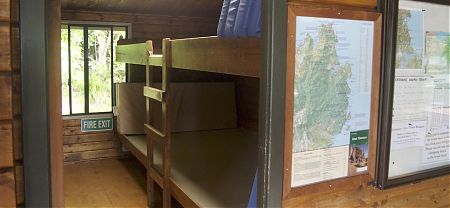Abel Tasman Coastal Track huts and campsites
The Anchorage Hut is 5 star accommodation. The others aren’t so bad either, it’s just that for much of the summer they are at capacity and that’s some crowd. You need earplugs to block out the ongoing activities, whether a whole lot of late-night laughing and hi jinks or some early morning plastic bag rustling.
The weather in Abel Tasman National Park is as benign as New Zealand offers, most of the time, and camping is a great option, particularly at the smaller, beachside, camping areas: Te Puketea Bay, Mutton Cove, etc. The bigger campsites: Anchorage, Bark Bay, Totaranui, offer more facilities: kitchen shelters, flush toilets, fireplaces with dry firewood supply, and the potential for a lot of close companionship over the summer.
Tonga Quarry has been permanently closed after substantial recent storm damage.
Akersten Bay campsite is a very cute, and small, campsite perched just above a sandy beach, nestled into the bush. First one there gets one of the best campsites in the park.
The area around Anapai is one of the most dramatic in Abel Tasman, those rock formations are speccy.
Anchorage campsite is the biggest, most populated, with most facilities, campsite, well, other than at Totaranui.
Smack on the splendid north facing beach, unveiled in October 2013, Anchorage Hut is genuine five-star accommodation, ie, flush toilets, double glazed, filtered water, four separate bedrooms, etc.
Apple Tree Bay campsite is a fairly exposed campsite right on the beach, ie, you camp straight on the sand and there isn’t much shade, but it does have proximity to Marahau.
Awaroa campsite is sheltered and sunny, at least when the sun is shining, with a range of facilities, adjacent to the Awaroa Hut and estuary.
Awaroa Hut is parked on the Awaroa estuary, it’s handy while waiting for that tide to recede, that’s if you’re on the hut side, if not, you can at least look at it and dream you are there.
The Bark Bay campsite is a big campsite with plenty of facilities set in kanuka scrub and set back from the big beach. A place to meet plenty of people in the summer months.
Bark Bay Hut is set back from the Bark Bay Beach, on the other side of the estuary, this is a reminder of how the huts in Abel Tasman used to be, comfortable and well equipped sufficiently, well, at least when it’s not totally chokka.
Mutton Cove campsite is widely regarded as the most attractive campsite in the national park, perched just above a golden beach, with that pure, clear water. Who am I to dispute that?
Onetahuti Bay campsite is a sheltered, grassy, campsite close to a big beach. Nice one.
There’s a reason Te Pukatea Bay campsite gets booked out early despite the minimal facilities: Te Puketea Bay is one of the most beautiful in the national park, and the campsite is perched in the bush just above it.
Tinline campsite is the closest campsite to Marahau has not so much to recommend it: it’s not adjacent to the beach, it’s on a considerable slope, plenty exposed, ie, no shade, although there are a few better sites nestled adjacent to the shrubbery.
Permanently closed.
Adjacent to the Torrent Bay estuary which is either tide in, or tide out. This is a no-frills campsite close to the Torrent Bay Village, which other than a few baches has few actual village qualities.
Totaranui has a massive summer campsite, like 870 playful campers in peak season, but there is a section set aside for walkers. The hitch is that you are only allowed to stay one night.
Waiharakeke Bay campsite is a sheltered site that though called Waiharakeke Bay is not so close to the beach.
Watering Cove campsite is a small campsite with a beach that almost disappears at high tide. The sites are good uns.
Whariwharangi Bay campsite is adjacent to the historic hut and a short walk from the beach. The campsites are sheltered from the wind, and catch all day sun, if the sun is out.
The historic, ie, around 1896, original farmhouse, now Whariwharangi Bay Hut, has been converted into cosy and comfortable tramper’s accommodation in this less travelled northern section of Abel Tasman.



















